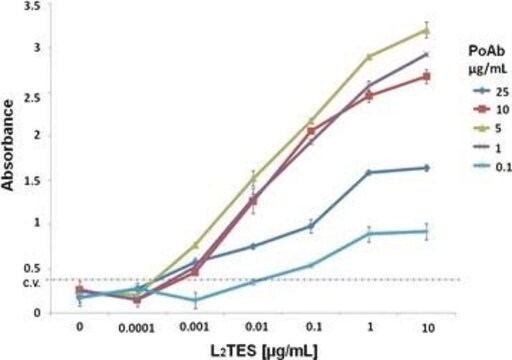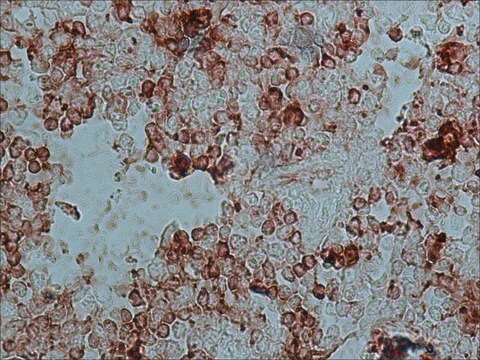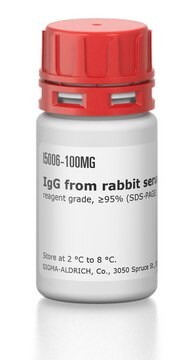R4880
Anti-Rabbit IgG (whole molecule) antibody produced in goat
affinity isolated antibody, lyophilized powder
Faça loginpara ver os preços organizacionais e de contrato
About This Item
Produtos recomendados
fonte biológica
goat
Nível de qualidade
conjugado
unconjugated
forma do anticorpo
affinity isolated antibody
tipo de produto de anticorpo
secondary antibodies
clone
polyclonal
Formulário
lyophilized powder
técnica(s)
immunoelectrophoresis: suitable
temperatura de armazenamento
2-8°C
modificação pós-traducional do alvo
unmodified
Procurando produtos similares? Visita Guia de comparação de produtos
Descrição geral
Binds all rabbit Igs.
Aplicação
Anti-Rabbit IgG (whole molecule) antibody produced in goat is suitable as secondary antibody in immunoblotting.
Applications in which this antibody has been used successfully, and the associated peer-reviewed papers, are given below.
Western Blotting (1 paper)
Western Blotting (1 paper)
Ações bioquímicas/fisiológicas
IgG antibody subtype is the most abundant of serum immunoglobulins of the immune system. It is secreted by B cells and is found in blood and extracellular fluids and provides protection from infections caused by bacteria, fungi and viruses. Maternal IgG is transferred to fetus through the placenta that is vital for immune defense of the neonate against infections.
Outras notas
Antibody adsorbed with human serum proteins.
forma física
Lyophilized from 0.01 M sodium phosphate, 0.015 M sodium chloride, pH 7.2
Reconstituição
Reconstitute with 0.135 M sodium chloride.
Exoneração de responsabilidade
Unless otherwise stated in our catalog or other company documentation accompanying the product(s), our products are intended for research use only and are not to be used for any other purpose, which includes but is not limited to, unauthorized commercial uses, in vitro diagnostic uses, ex vivo or in vivo therapeutic uses or any type of consumption or application to humans or animals.
Não está encontrando o produto certo?
Experimente o nosso Ferramenta de seleção de produtos.
Código de classe de armazenamento
11 - Combustible Solids
Classe de risco de água (WGK)
WGK 3
Ponto de fulgor (°F)
Not applicable
Ponto de fulgor (°C)
Not applicable
Equipamento de proteção individual
Eyeshields, Gloves, type N95 (US)
Escolha uma das versões mais recentes:
Já possui este produto?
Encontre a documentação dos produtos que você adquiriu recentemente na biblioteca de documentos.
Os clientes também visualizaram
On-site quantification of human urinary albumin by a fluorescence immunoassay.
Sunga Choi et al.
Clinical chemistry, 50(6), 1052-1055 (2004-05-27)
M Rudling et al.
The American journal of pathology, 153(6), 1923-1935 (1998-12-10)
The high-affinity degradation of low-density lipoprotein (LDL) is enhanced 3- to 100-fold in leukemic blood cells from patients with acute myelogenous leukemia (AML), suggesting an increased cellular LDL receptor expression. There are, however, inconsistencies regarding the published properties of LDL
Jinsu Kim et al.
ACS applied materials & interfaces, 7(4), 2891-2898 (2015-01-13)
We demonstrated a lateral flow immunoassay (LFA) for detection of viruses using fluorescently labeled M13 bacteriophage as reporters and single-reporter counting as the readout. AviTag-biotinylated M13 phage were functionalized with antibodies using avidin-biotin conjugation and fluorescently labeled with AlexaFluor 555.
Shanshan Huang et al.
Pathology, research and practice, 215(4), 794-800 (2019-01-27)
Numbers of studies have indicated that miRNA-708 plays an important role in many types of cancer. However, the role of miRNA-708 in pancreatic ductal adenocarcinoma (PDAC) has yet to be fully elucidated. The present study aimed to investigate the role
Peter Engelhardt et al.
Methods in molecular biology (Clifton, N.J.), 369, 387-405 (2007-07-28)
Standard immunogold-labeling methods in transmission electron microscopy (TEM) are unable to locate immunogold particles in the depth direction. This inability does not only concern bulky whole mounts, but also sections. A partial solution to the problem is stereo inspection. However
Nossa equipe de cientistas tem experiência em todas as áreas de pesquisa, incluindo Life Sciences, ciência de materiais, síntese química, cromatografia, química analítica e muitas outras.
Entre em contato com a assistência técnica










